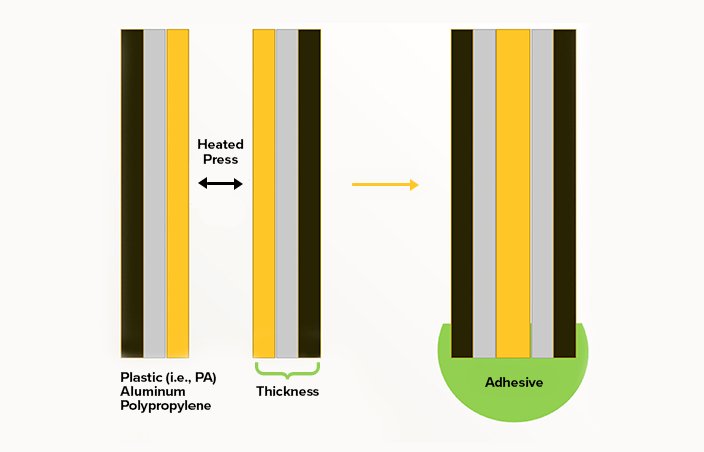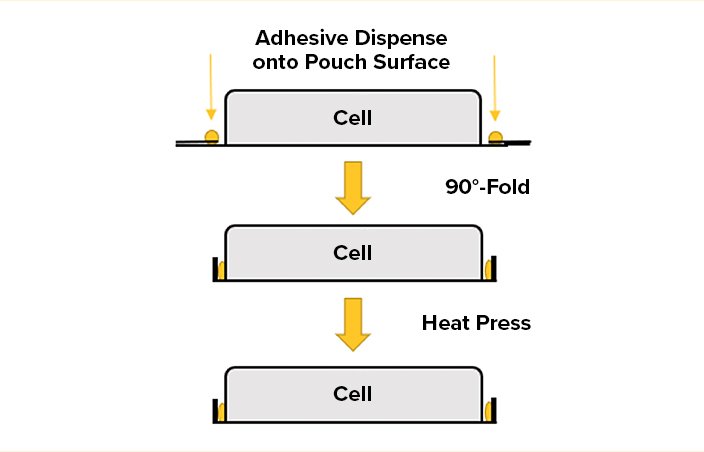KRYLEX Adhesives for Next-Generation Battery Pouch Cell Bonding and Sealing Applications

Demand for high-density portable power has never been higher. Lithium-ion batteries (LIB) are the dominant battery technology used in today’s portable and mobile electronic devices as well as in the rapidly growing Electric Vehicles (EV) market. The global lithium-ion battery market is projected to grow at CAGR of 15% and be $56 billion by 2024.
Lithium-ion batteries are chosen by device manufactures for their high energy capacity and high cycle life, meaning they can be charged and discharged many times without degrading. While significant investment is driving research into new battery technologies such solid-state and DNV, Lithium-ion batteries are likely to remain the dominant technology for the foreseeable future, while, in addition, efforts continue to drive existing Li-ion technology to the next level.
There are several different kinds of unit cell that are being used in modules today, each with its own benefits and limitations. The most popular cell configurations in EVs are cylindrical, prismatic and pouch cells. Pouch cells are mainly being used in consumer electronic devices however use of pouch cells in EVs is increasingly being adopted more widely.
Pouch Cells:
Pouch cells are ideal for electronic device battery applications because they make efficient use of space and achieve packaging efficiency greater than 90-95%. Pouch cells also eliminate the need for metal enclosures which helps reduce weight which is an important priority whether using in an Electronic vehicle or common consumer products like Smartphones, Tablets, wearable devices and laptops. The pouch cell offers a simple and flexible option for manufacturers of battery cells however exposure to high humidity and elevated temperature can shorten the life of battery. As such, the materials used in construction of a Pouch Cell need careful consideration.
The pouch cell manufacturing process utilise adhesives in the construction of the final product to both bond and seal the final product. The main objective of the adhesives is to provide structural integrity and to protect the module from any moisture intrusion or chemical leakages – preventing the inside of the battery from exposure to the environment. Critical performance characteristics of the adhesive sealants include the ability to maintain proper seals while exposed to various conditions. These conditions can include any combination of the following: thermal cycling or thermal shock at typical temperature ranges of -40°C to 80°C, high humidity environments, standard automotive chemicals such as oils and coolants and mechanical forces seen during vehicle operations such as vibration, impact, shear, and compression.
Adhesive Technologies for Pouch Cell Bonding and Sealing:
There are several adhesive technologies that can be considered for doing Pouch Cell bonding and sealing. Initially PSA tape adhesives were adopted because they offered high degree of reworkability and excellent impact strength. However, tape adhesives also presented challenges. PSA tapes and films do not lend themselves to achieving thin bond line thicknesses required and are also more difficult/ slow to apply robustly (lower UPH).
Adhesive tapes also use liners that must be removed and create significant environmental concerns around waste. The fact that tape adhesives are more expensive to buy and use than other technologies is a further negative.
Because of the issues around the use of tape adhesives, a shift was made more towards liquid-paste adhesives. Initially the paste adhesive chemistry of choice was Polyurethane Hot Melts. PUR’s exceeds tape adhesives in terms of bond strength and overall pouch cell reliability. KRYLEX 8827-15B PUR formulation is widely used in the industry because it offers manufacturers rapid, high ‘green’ strength development after initial bonding, is low odor and has excellent dispense characteristics making it easy to use and apply in HVM. The pouch cell bonding process using a PUR requires the adhesive be dispensed onto the pouch and then fold and press to create the bond, see Figure 1.

Figure 1
Recently there has been a further shift toward adopting UV Curable adhesives as a liquid-paste solution for the pouch cell sealing. As the industry is adopting new designs around the Pouch cell’s themselves UV curable solutions are offering performance advantages in respect of pouch cell sealing. UV adhesive pouch sealing, unlike PUR pouch cell bonding, involves sealing the pouch along the edge, see Figure 2.

Figure 2
Krylex’s UV Curable Sealants for Pouch Cell:
Krylex’s UV Curable sealant formulations are offering customers leading product performance to meet the current and next-generation Pouch Cell performance and design requirements. Krylex KU5100 series products are 1 part (pre-mixed) adhesive formulas designed to cure rapidly when exposed to the appropriate intensity of UV light. The products have optimized rheology to enable easy application by automated dispense equipment. When using a broadband UV light source to complete the product curing the adhesives will cure in around 2 seconds to help maximize UPH Efficiency on the production line. In addition, the adhesives have very low shrinkage during the UV curing process, ensuring that associated stresses are minimized on the Pouch cell-substrate surfaces.
Once cured the products are designed to have a low surface tack. When doing sealing of pouch cells, it is critical that the adhesive cured surface has a low surface tack so that random material particulates do not contact and stick to the adhesive surface. Residual material accumulating in the adhesive area due to a tacky surface can result in battery shorts and total failure.
The products have excellent adhesion to the Nylon and PET substrate surfaces. They provide high scratch, tear, and abrasion resistance (pencil hardness >5H) while maintaining excellent flexibility to easily pass flex and bend requirements. The products also meet or exceed the industry requirements in respect of Thermal cycling, damp heat aging and chemical resistance.
Summary:
Krylex’s performance adhesives for pouch cells have led the shift away from tape adhesives to liquid-paste adhesives that are applied by an easy automated dispense process.
These liquid adhesives, both PUR and UV Chemistries, have not only improved pouch cell manufacturability but have improved reliability and helped drive down costs and reduce wastage.
Krylex’s KU5100 series are ideal next generation Pouch Cell sealants, maximising production efficiencies to work with new and developing pouch design technologies.
Ultra-rapid UV cure fixation, low shrinkage and high reliability put these new products at the top of the industry for current and next generation pouch cell sealing.
For more information, please contact your local KRYLEX representative:
Paul Gleeson – Global Key Account Manager – Electronics, pgleeson@chemence.com
July 30, 2021
Krylex